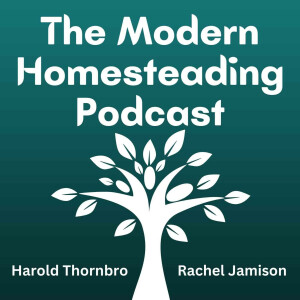
The Modern Homesteading Podcast
Society & Culture:Personal Journals
The Modern Homesteading Podcast, Episode 125 – September 3, 2019 - Increasing Soil Fertility Through Permaculture Practices.
In this episode I discuss a few ways to help soil fertility in ways normally exercised in permaculture practices. These are ways that are simulated in nature to create balanced, rich and living soil.
Using Plants To Increase Soil Fertility
Polycultures and Guilds
Nitrogen fixing plants
Fast decaying root systems
Using Chop and Drop To Increase Soil Fertility
Puts nutrients on topsoil
Creates an environment for worms and beneficial insects
Creates an environment for a thriving microbiology
Using Livestock To Increase Soil Fertility
Rotational grazing
Using Swales and Ponds To Collect Nutrients
Using Hugelkultur To Create A Nutrient Dense Area
Increases microbiology through organic material decay and moisture retention.
Using Biochar
By making biochar from brush and other hard to compost organic material, you can improve soil — it enhances nutrient availability and also enables soil to retain nutrients longer.
What’s biochar? Basically, it’s organic matter that is burned slowly, with a restricted flow of oxygen, and then the fire is stopped when the material reaches the charcoal stage. Unlike tiny tidbits of ash, coarse lumps of charcoal are full of crevices and holes, which help them serve as life rafts to soil microorganisms. The carbon compounds in charcoal form loose chemical bonds with soluble plant nutrients so they are not as readily washed away by rain and irrigation. Biochar alone added to poor soil has little benefit to plants, but when used in combination with compost and organic fertilizers, it can dramatically improve plant growth while helping retain nutrients in the soil.
Using Leaf Mold
Leaf mold is the result of letting leaves sit and decompose over time. It is dark brown to black, has a pleasant earthy aroma and a crumbly texture, much like compost. In fact, leaf mold is just that: composted leaves. Instead of adding a bunch of organic matter to a pile, you just use leaves.
Leaf mold is essentially a soil conditioner. It increases the water retention of soils. According to some university studies, the addition of leaf mold increased water retention in soils by over 50%. Leaf mold also improves soil structure and provides a fantastic habitat for soil life, including earthworms and beneficial bacteria.
Using Fungus
For feeding fungi, the ideal wood chips should be obtained from freshly cut smaller branches with the leaves still on them. That’s where the most nutrients reside and the good fungi love that.
Beneficial fungi are certain species of fungi that protect our plants from disease by:
Out-competing disease organisms
Creating a healthy soil biology
Offering direct protection to our plants by producing anti-pathogens
Providing nutrients and water directly to the plants for better plant health
Compost Tea
Comfrey
Manure
Vermicompost
Worm Castings
More Episodes
Function Stacking On Small Scale Homesteads
 2018-04-16
2018-04-16
Destructive Insect Control For Organic Gardening
 2018-03-31
2018-03-31
Raising Coturnix Quail On The Homestead
 2018-03-18
2018-03-18
Homesteaders Share Why They Started Homesteading
 2018-03-12
2018-03-12
Living Fences: Trees, Hedges and Fedges
 2018-02-25
2018-02-25
10 Things I Don’t Want You To Know About Me
 2018-02-17
2018-02-17
The Wormcast: All About Vermicomposting
 2018-02-04
2018-02-04
27 Movies For Homesteading Inspiration
 2018-01-28
2018-01-28
Homesteaders Need To Know About Coccidiosis
 2018-01-13
2018-01-13
Announcements and Recommendations
 2017-12-23
2017-12-23
Q & A Episode: Mistakes, Regrets, Farm Sitters, Soil Tests and More
 2017-12-10
2017-12-10
The Underappreciated Mulberry Tree
 2017-12-04
2017-12-04
Pioneer Roots With Guest Melissa K. Norris
 2017-11-20
2017-11-20
5 Reasons You Might Fail As A Homesteader
 2017-10-29
2017-10-29
Build Your Own Homestead Hardware Store
 2017-10-14
2017-10-14
Homesteading When Your Spouse Isn’t On Board
 2017-10-01
2017-10-01
Container Gardening
 2017-09-18
2017-09-18
Seed Saving for Self Sufficiency
 2017-08-20
2017-08-20
Creating and Utilizing Microclimates
 2017-08-13
2017-08-13
All About Comfrey On The Homestead
 2017-05-21
2017-05-21
Create your
podcast in
minutes
- Full-featured podcast site
- Unlimited storage and bandwidth
- Comprehensive podcast stats
- Distribute to Apple Podcasts, Spotify, and more
- Make money with your podcast
It is Free
You may also like

Jim Harold’s Campfire


The Armie HammerTime Podcast


Uncanny


Reroot with Eamon and Bec


Witch


- Privacy Policy
- Cookie Policy
- Terms of Use
- Consent Preferences
- Copyright © 2015-2024 Podbean.com


 iOS
iOS Android
Android